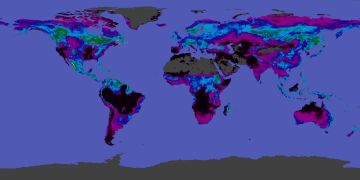
 |
||
|
|
||
| View other datasets |
|
|
| ||
 |
|||
| Coverage of this dataset spans March 2000 to August 2005. | |||
The animation features of the Earth Observatory are currently unavailable. We apologize for the inconvenience. To view the full temporal span of this dataset, please view the Primary Productivity monthly holdings. | |||
 Product description: Net Primary Production (NPP) is an indicator of the biological productivity of vegetation, both land-based (terrestrial) and ocean-based (marine). This important vegetation characteristic is called net production because it indicates how much carbon dioxide is taken in by vegetation during photosynthesis minus how much is given off during respiration, which is the process by which organisms use food to produce energy. The maps above show terrestrial and marine NPP for the month indicated. Values range from 0 to 3 kilograms of carbon per square meter per year (kgC/m2/year) in shades of black to dark red. The primary purpose of NPP measurements is to provide information on the global carbon cycle--all the ways carbon is exchanged among land, life, ocean, and atmosphere. With increasing global concentration of atmospheric carbon dioxide being linked to increasing temperatures, scientists are working to make the best possible models of the movement of carbon into and out of all environments on Earth. Carbon cycle models are closely tied to global climate models, and regular measurements of NPP are essential for both. On land, NPP monitors global ecological conditions like changes in plant distribution and vigor in response to large-scale shifts in climate, deforestation, desertification, pollution damage, glacial retreats, flooding, wildfires, and urbanization. On a short-term basis, NPP provides information on vegetation characteristics that have important social and economic impacts, including crop yields, range land forage, and forest production. In the ocean, NPP provides similar insights into climate shifts and ecological conditions. With respect to climate, marine NPP is closely tied to temperature in a somewhat surprising way. Whereas on land vegetation usually thrives in warmer conditions (up to a point), marine plants are more productive where cold, nutrient-rich waters have welled up to the surface from deep in the ocean. This intimate link between temperature and productivity means that large-scale changes in marine NPP could be a signal of climate change. Marine NPP is an important indicator of the health of the plant life that is at the base of the oceanic food web--phytoplankton.
|
|
Subscribe to the Earth Observatory About the Earth Observatory Contact Us Privacy Policy and Important Notices Responsible NASA Official: Lorraine A. Remer Webmaster: Goran Halusa We're a part of the Science Mission Directorate |